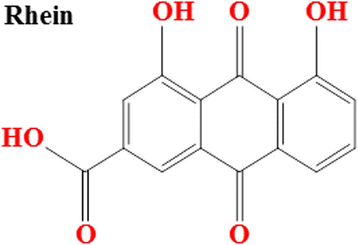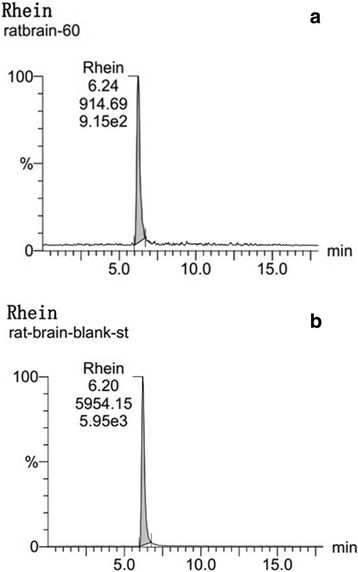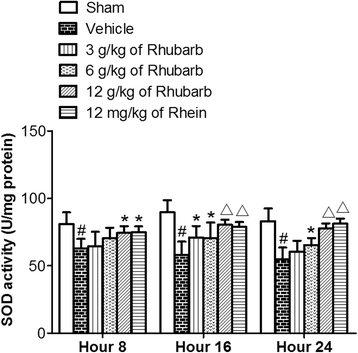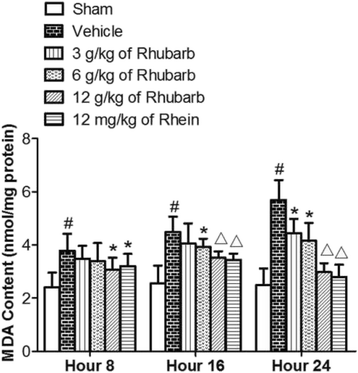Rhein exhibits antioxidative effects similar to Rhubarb in a rat model of traumatic brain injury
- PMID: 28264680
- PMCID: PMC5340037
- DOI: 10.1186/s12906-017-1655-x
Rhein exhibits antioxidative effects similar to Rhubarb in a rat model of traumatic brain injury
Abstract
Background: The brain is secondarily harmed by pathological, physiological, and biological reactions that are caused by traumatic brain injury (TBI). Rhein, a significant composition of Rhubarb, is a well-known traditional Chinese treatment method and has a strong oxidation-resisting characteristic, but Rhein's mechanism remains unclear.
Methods: This study aimed to identify Rhein in the brain tissues of TBI model of rats, and confirm whether Rhein induced an antioxidative effect similar to its parent medicine, Rhubarb. First, the ultra performance liquid chromatography-tandem mass spectrometry (UPLC-MS/MS) method was applied to identify Rhein in the brain tissue of the controlled cortical impact (CCI) rats after intra-gastric administration of Rhubarb. Further, for the purpose of calculating the oxidant stress of the CCI rats, the malondialdehyde (MDA), catalase (CAT), superoxide dismutase (SOD), and glutathione disulfide (GSSG), as well as the proportion of glutathione (GSH)/GSSG were measured in the brain tissues.
Results: The results showed that Rhein was absorbed in the brain tissues of CCI rats. Rhubarb and rhein elevated the SOD, CAT activities, GSH level, and GSH/GSSG ratio, and diminished the MDA and GSSG levels.
Conclusion: The data demonstrated that Rhubarb and Rhein had the potential to be used as a neuroprotective drug for TBI, and that Rhein induced an antioxidative effect similar to its parent medicine, Rhubarb.
Keywords: Neuroprotective effect; Oxidative stress; Rhein; Rhubarb; Traumatic brain injury.
Figures





Similar articles
-
Neuroprotective Effects of Anthraquinones from Rhubarb in Central Nervous System Diseases.Evid Based Complement Alternat Med. 2019 May 16;2019:3790728. doi: 10.1155/2019/3790728. eCollection 2019. Evid Based Complement Alternat Med. 2019. PMID: 31223328 Free PMC article. Review.
-
Rhein and rhubarb similarly protect the blood-brain barrier after experimental traumatic brain injury via gp91phox subunit of NADPH oxidase/ROS/ERK/MMP-9 signaling pathway.Sci Rep. 2016 Nov 30;6:37098. doi: 10.1038/srep37098. Sci Rep. 2016. PMID: 27901023 Free PMC article.
-
Hydroxysafflor yellow A exerts antioxidant effects in a rat model of traumatic brain injury.Mol Med Rep. 2016 Oct;14(4):3690-6. doi: 10.3892/mmr.2016.5720. Epub 2016 Sep 6. Mol Med Rep. 2016. PMID: 27599591 Free PMC article.
-
An ultra high performance liquid chromatography with tandem mass spectrometry method for plasma and cerebrospinal fluid pharmacokinetics of rhein in patients with traumatic brain injury after administration of rhubarb decoction.J Sep Sci. 2015 Apr;38(7):1100-8. doi: 10.1002/jssc.201401197. Epub 2015 Mar 2. J Sep Sci. 2015. PMID: 25598181
-
Research Progress on the Positive and Negative Regulatory Effects of Rhein on the Kidney: A Review of Its Molecular Targets.Molecules. 2022 Oct 4;27(19):6572. doi: 10.3390/molecules27196572. Molecules. 2022. PMID: 36235108 Free PMC article. Review.
Cited by
-
Neuroprotective Effects of Anthraquinones from Rhubarb in Central Nervous System Diseases.Evid Based Complement Alternat Med. 2019 May 16;2019:3790728. doi: 10.1155/2019/3790728. eCollection 2019. Evid Based Complement Alternat Med. 2019. PMID: 31223328 Free PMC article. Review.
-
Rhein Alleviates Doxorubicin-Induced Myocardial Injury by Inhibiting the p38 MAPK/HSP90/c-Jun/c-Fos Pathway-Mediated Apoptosis.Cardiovasc Toxicol. 2024 Nov;24(11):1139-1150. doi: 10.1007/s12012-024-09917-7. Epub 2024 Sep 6. Cardiovasc Toxicol. 2024. PMID: 39240427
-
DHZCP Modulates Microglial M1/M2 Polarization via the p38 and TLR4/NF-κB Signaling Pathways in LPS-Stimulated Microglial Cells.Front Pharmacol. 2020 Jul 30;11:1126. doi: 10.3389/fphar.2020.01126. eCollection 2020. Front Pharmacol. 2020. PMID: 32848745 Free PMC article.
-
The Great Healing Potential Hidden in Plant Preparations of Antioxidant Properties: A Return to Nature?Oxid Med Cell Longev. 2020 Oct 9;2020:8163868. doi: 10.1155/2020/8163868. eCollection 2020. Oxid Med Cell Longev. 2020. PMID: 33101592 Free PMC article. Review.
-
Chrysophanol protects human bronchial epithelial cells from cigarette smoke extract (CSE)-induced apoptosis.Int J Mol Epidemiol Genet. 2020 Dec 15;11(3):39-45. eCollection 2020. Int J Mol Epidemiol Genet. 2020. PMID: 33488953 Free PMC article.
References
-
- Toklu, HZ, Tumer N. Oxidative Stress, Brain Edema, Blood-brain Barrier Permeability, and Autonomic Dysfunction from Traumatic Brain Injury, in Brain Neurotrauma: Molecular, Neuropsychological, and Rehabilitation Aspects, F.H. Kobeissy, Editor. Boca Raton (FL): Frontiers in Neuroengineering; 2015.
-
- Laskowski, RA, Creed JA, Raghupathi R. Pathophysiology of Mild TBI: Implications for Altered Signaling Pathways, in Brain Neurotrauma: Molecular, Neuropsychological, and Rehabilitation Aspects, F.H. Kobeissy, Editor. Boca Raton (FL): Frontiers in Neuroengineering; 2015. - PubMed
MeSH terms
Substances
LinkOut - more resources
Full Text Sources
Other Literature Sources
Medical
Miscellaneous

